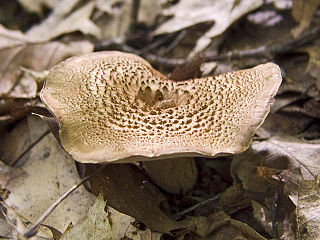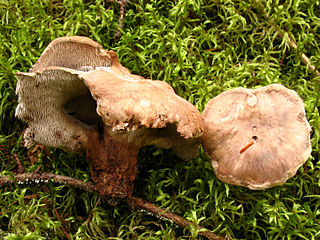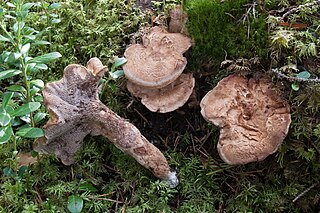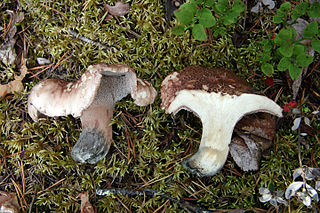
Hydnellum is a genus of tooth fungi in the family Bankeraceae. Widely distributed in the Northern Hemisphere, the genus contains around 40 species. The fruitbodies of its members grow by slowly enveloping nearby bits of grass and vegetation. There is great variability in the form of Hydnellum fruitbodies, which are greatly influenced by environmental conditions such as rainfall and humidity, drying winds, and temperature. They are too tough and woody to eat comfortably. Several species have become the focus of increasing conservation concern following widespread declines in abundance.

Phellodon is a genus of tooth fungi in the family Bankeraceae. Species have small- to medium-sized fruitbodies with white spines on the underside from which spores are released. All Phellodon have a short stalk or stipe, and so the genus falls into the group known as stipitate hydnoid fungi. The tough and leathery flesh usually has a pleasant, fragrant odor, and develops a cork-like texture when dry. Neighboring fruitbodies can fuse, sometimes producing large mats of joined caps. Phellodon species produce a white spore print, while the individual spores are roughly spherical to ellipsoid in shape, with spiny surfaces.

Sarcodon is a genus of fungi in the family Bankeraceae, which is part of the order Thelephorales known for its almost universal ectomycorrhizal life style. The genus owes its name to the presence of teeth-like spines on the hymenophore, it is derived from ancient Greek; sarco = flesh and odon = tooth. This is why they are commonly called "tooth fungi", or "Hydnoid fungi".

Hydnellum fuscoindicum is a species of tooth fungus in the genus Hydnellum. It is found in the Pacific Northwest in moss around western hemlocks. It produces fruit bodies with a violet-black cap, violet flesh, and violet spines on the cap underside. The odor and taste are very farinaceous. The fungus was first described by Kenneth A. Harrison in 1964 as a species of Hydnum, then transferred to Sarcodon in 1967 by Rudolph Arnold Maas Geesteranus. He placed this species in section Violacei of Sarcodon, along with H. fuligineoviolaceum and H. joeides.
Hydnellum subzonatum is a tooth fungus in the family Bankeraceae. Found in Nova Scotia, Canada, it was described as new to science in 1961 by mycologist Kenneth A. Harrison. Its small fruitbodies grow as fused caps, with individual caps measuring 1.3–5 cm (1–2 in) in diameter. Initially white, they turn light brown with a somewhat darker center, and are faintly zonate. The grayish-blue spines on the cap underside are up to 3 mm long. Growing fruitbodies have an unusual hoary (grayish-white) appearance. The spores are oblong to almost square, measuring 3.5–4.5 by 3.4 µm. The fungus fruits in groups under spruce. H. subzonatum has been collected from Cape Split and Antigonish County.
Hydnellum cruentum is a tooth fungus in the family Bankeraceae. Found in Nova Scotia, Canada, it was described as new to science in 1961 by mycologist Kenneth A. Harrison. Fruitbodies grow singly, in groups, or as fused masses under spruce. Individual caps measure 3–10 cm (1.2–3.9 in) in diameter, and have a club- or cushion-like shape. They are initially light brown, but darken somewhat in maturity. Young fruitbodies can exude droplets of red juice. Spines on the cap underside are lilac to dark blue, and up to 4 mm long. The angular spores are angular, with 4 to 6 unusually prominent outgrowths, and measure 4–4.5 by 3.5–4.5 µm. Harrison described the spores as "so irregular that some resemble stout metal jackstones." The flesh is pale gray to pale brown, and has a strong "medicinal" odor.
Hydnellum multiceps is a rare species of tooth fungus in the family Bankeraceae. Found in Nova Scotia, Canada, it was described as new to science in 1961 by mycologist Kenneth A. Harrison. The fungus has fruitbodies of overlapping and fused caps. Single caps measure 3–5 cm (1.2–2.0 in) in diameter, while fused masses can be up to 30 cm (12 in) in diameter and 8 cm (3 in) tall. The upper cap surface is initially pale brown but darken in maturity. The greyish-brown to dark brown spines on the cap underside measure 2–5 mm long. The fungus has been recorded growing as a partial fairy ring measuring about 20 ft (6 m) in diameter, in spruce woods in Glenmont, Nova Scotia; it has also been recorded from Cape Breton Island. The spores are roughly spherical with sharp processes, and dimensions of 3–4.5 by 3–4 µm.
Hydnellum frondosum is a tooth fungus in the family Bankeraceae. Found in Nova Scotia, Canada, it was described as new to science in 1961 by mycologist Kenneth A. Harrison. Its fruitbodies have caps that individually measure 1.8–4 cm (0.7–1.6 in) across, but can coalesce to create larger fused structures up to 14 cm (5.5 in). The cap surface is greyish brown, with broad whitish margins in age. The spines on the cap underside are small–up to 1 mm long, and extend quite a ways down the length of the stipe. The spore print is fawn; individual spores are roughly spherical and measure 3.5–4.5 by 3–4 µm. Fruit bodies have been found growing near pine and hemlock, in mixed forest of Kings County, Nova Scotia.

Hydnellum scrobiculatum, commonly known as the ridged tooth, is a tooth fungus in the family Bankeraceae. Widely distributed in the Northern Hemisphere, it is found in Asia, Europe, and North America.

Hydnellum underwoodii is an inedible species of tooth fungus in the family Bankeraceae. Found in North America, it was described as new to science in 1906 by American mycologist Howard James Banker. Its reddish-brown, convex to flattened cap measures 5–14 cm (2.0–5.5 in) in diameter. Reddish-brown, partially erect scales adorn the cap surface. Spines on the cap underside are 1–3 mm long; they are initially white, becoming brown with grayish tips in age. The oval to spherical spores are 6–7.5 by 5.5–6.5 µm. The fungus fruits singly or scattered, on the ground in coniferous forests.

Sarcodon stereosarcinon is a species of tooth fungus in the family Bankeraceae. Found in North America, it was described as new to science in 1940 by mycologist Lewis Edgar Wehmeyer, who found the original collections in Nova Scotia, Canada.

Hydnellum fuligineoviolaceum is a species of tooth fungus in the family Bankeraceae. It was originally described in 1874 by Hungarian mycologist Károly Kalchbrenner as Hydnum fuligineoviolaceum, in Elias Fries's work Hymenomycetes europaei. Narcisse Théophile Patouillard transferred it to the genus Sarcodon in 1900. Sarcodon talpa, published by Rudolph Arnold Maas Geesteranus in 1967, is a synonym.

Hydnellum amygdaliolens is a species of tooth fungus in the family Bankeraceae. Found in the Iberian Peninsula, it was described as new to science in 2011. It smells strongly of bitter almonds. Its spores measure 5.25–6.5 by 4.5 μm.
Sarcodon lanuginosus is a species of tooth fungus in the family Bankeraceae. It was described as new to science in 1961 by mycologist Kenneth A. Harrison, who initially called it Hydnum lanuginosum. He transferred it to the genus Sarcodon in 1984. It is found in Nova Scotia, Canada, where it fruits on the ground singly or in groups under spruce and fir. The type collection was made in Cape Split, Kings County.

Hydnellum martioflavum is a species of tooth fungus in the family Bankeraceae, found in Europe and North America.

Hydnellum joeides is a species of tooth fungus in the family Bankeraceae.

Hydnellum fennicum is a species of tooth fungus in the family Bankeraceae. It was originally described by Petter Karsten in 1882 as a variety of Sarcodon scabrosus. Karsten promoted it to a distinct species in 1887. It is considered critically endangered in Switzerland. It is inedible.
Kenneth A. Harrison was a Canadian mycologist. He was for many years a plant pathologist at what is now the Atlantic Food and Horticulture Research Centre in Nova Scotia. After retirement, he contributed to the taxonomy of the Agaricomycotina, particularly the tooth fungi of the families Hydnaceae and Bankeraceae, in which he described several new species.
Sarcodon subfelleus is a species of tooth fungus in the family Bankeraceae. It was described as new to science in 1961 by mycologist Kenneth A. Harrison, who initially called it Hydnum subfelleum. He transferred it to the genus Sarcodon in 1984. It is found in Nova Scotia, Canada, where it fruits on the ground singly or in groups under spruce and fir. The type collection was made in Glenmont, Kings County.

Hydnellum scabrosum, also called bitter tooth or bitter hedgehog, is a species of tooth fungus in the family Bankeraceae.













